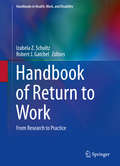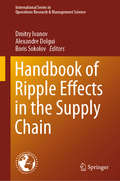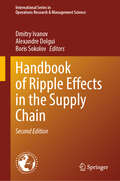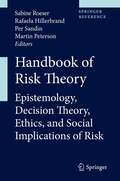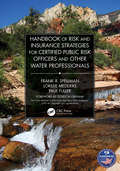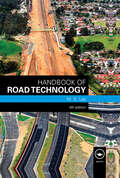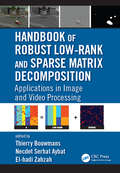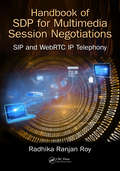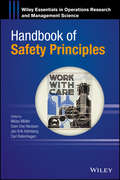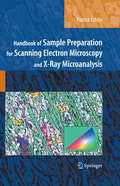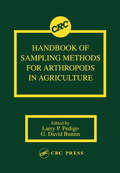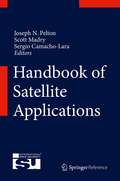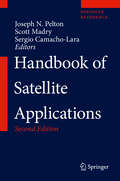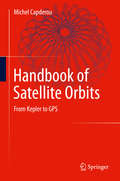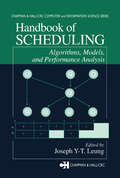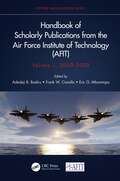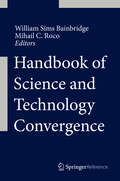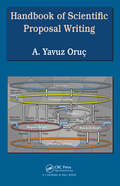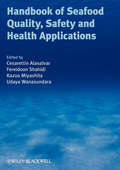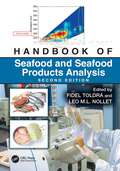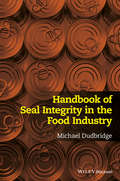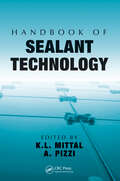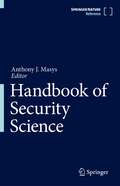- Table View
- List View
Handbook of Retrofitting High Density Residential Buildings: Policy Design and Implications on Domestic Energy Use in the Eastern Mediterranean Climate of Cyprus
by Bertug Ozarisoy Hasim AltanThis book investigates energy use and measures to improve the energy efficiency of public housing, using post-war social housing development estates in Cyprus as its example. On this Mediterranean island, which experiences hot and humid temperatures throughout the year, residential buildings need to adapt to the climate to improve the thermal comfort of their occupants. The book assesses the domestic energy use of inefficiently built residential tower blocks and their occupants’ thermal comfort by considering the significant impact of overheating risks on energy consumption and occupants’ thermal comfort and well-being, with the intention of evaluating the current energy performance of base-case representative residential tower blocks (RTBs). In particular, considering the cooling energy demand in the summer, using Famagusta, Cyprus as a case study. It seeks to identify the impact of occupancy patterns and habitual adaptive behaviour of households on home energy performance in order to provide bases for the information needed to calibrate building energy performance of targeted households.
Handbook of Return to Work
by Izabela Z. Schultz Robert J. GatchelThis comprehensive interdisciplinary synthesis focuses on the clinical and occupational intervention processes enabling workers to return to their jobs and sustain employment after injury or serious illness as well as ideas for improving the wide range of outcomes of entry and re-entry into the workplace. Information is accessible along key theoretical, research, and interventive lines, emphasizing a palette of evidence-informed approaches to return to work and stay at work planning and implementation, in the context of disability prevention. Condition-specific chapters detail best return to work and stay at work practices across diverse medical and psychological diagnoses, from musculoskeletal disorders to cancer, from TBI to PTSD. The resulting collection bridges the gap between research evidence and practice and gives readers necessary information from a range of critical perspectives. Among the featured topics: Understanding motivation to return to work: economy of gains and losses. Overcoming barriers to return to work: behavioral and cultural change. Program evaluation in return to work: an integrative framework. Working with stakeholders in return to work processes. Return to work after major limb loss. Improving work outcomes among cancer survivors. Return to work among women with fibromyalgia and chronic fatigue syndrome. The Handbook of Return to Work is an invaluable, unique and comprehensive resource for health, rehabilitation, clinical, counselling and industrial psychologists, rehabilitation specialists, occupational and physical therapists, family and primary care physicians, psychiatrists and physical medicine and rehabilitation as well as occupational medicine specialists, case and disability managers and human resource professionals. Academics and researchers across these fields will also find expert guidance and direction in these pages. It is an essential reading for all return to work and stay at work stakeholders.
Handbook of Rf and Microwave Power Amplifiers
by John WalkerWhether you are an RF transistor designer, an amplifier designer or a system designer, this is your one-stop guide to RF and microwave transistor power amplifiers. A team of expert authors brings you up to speed on every topic, including: devices (Si LDMOS and VDMOS, GaAs FETs, GaN HEMTs), circuit and amplifier design (discrete, hybrid and monolithic), CAD, thermal design, reliability, and system applications/requirements for RF and microwave transistor amplifiers. Covering state-of-the-art developments and emphasising practical communications applications, this is the complete professional reference on the subject.
Handbook of Ripple Effects in the Supply Chain (International Series in Operations Research & Management Science #276)
by Dmitry Ivanov Alexandre Dolgui Boris SokolovThis book offers an introduction to the ripple effect in the supply chain for a broad audience comprising recent developments. The chapters of this handbook are written by leading experts in supply chain risk management and resilience. For the first time, the chapters present in their synergy a multiple-faceted view of the ripple effect in supply chains, while considering organization, optimization, and informatics perspectives. Ripple effect describes the impact of a disruption propagation on supply chain performance, structural designs and operational parameters. The ripple effect manifests when the impact of a disruption cannot be localized and cascades along the supply chain. The resulting structural dynamics can lead to capacity and demand fulfilment downscaling and negatively influence the firm’s financial and operational performance. The book delineates major features of the ripple effect and methodologies to mitigate the adverse impact of supply chain disruption propagation and to recover in case of severe disruptions. The book provides fresh insights for supply chain management and engineering regarding the following questions: - In what circumstance does one failure cause other failures? - Which structures of the supply chain are especially susceptible to the ripple effect? - What are the typical ripple effect scenarios and what are the most efficient ways to respond them? Distinctive Features: • It considers ripple effect in the supply chain from an multi-disciplinary perspective• It offers an introduction to ripple effect mitigation and recovery policies in the framework of disruption risk management in supply chains for a broad audience• It integrates management and engineering perspectives on disruption risk management in the supply chain• It presents innovative optimization and simulation models for real-life management problems• It considers examples from both industrial and service supply chains• It reveals decision-making recommendations for tackling disruption risks in the supply chain in proactive and reactive domains.
Handbook of Ripple Effects in the Supply Chain (International Series in Operations Research & Management Science #276)
by Dmitry Ivanov Alexandre Dolgui Boris SokolovThis book highlights the major features of the ripple effect and introduces methodologies to mitigate its adverse impact on supply chain resilience and to recover from severe disruptions. It brings fresh insights into the fields of supply chain management and engineering, addressing three fundamental questions: &“In what circumstance does one failure trigger others?&” &“Which supply chain structures are especially susceptible to the ripple effect?&” &“What are the typical ripple effect scenarios and the most efficient ways to respond to them?&” In this new edition, recent advancements are incorporated, particularly in areas such as supply chain viability, digital supply chains, artificial intelligence, and epidemiological models. Furthermore, it introduces new methodologies with a particular emphasis on data-driven and AI-based approaches. This comprehensive book provides innovative optimization and simulation models to address real-world challenges. With examples from industrial and service sectors, it offers actionable decision-making recommendations for tackling disruption risks in the supply chain proactively and reactively. As such the book is a comprehensive source for diverse readerships.
Handbook of Risk Theory
by Martin Peterson Sabine Roeser Per Sandin Rafaela HillerbrandRisk has become one of the main topics in fields as diverse as engineering, medicine and economics, and it is also studied by social scientists, psychologists and legal scholars. But the topic of risk also leads to more fundamental questions such as: What is risk? What can decision theory contribute to the analysis of risk? What does the human perception of risk mean for society? How should we judge whether a risk is morally acceptable or not? Over the last couple of decades questions like these have attracted interest from philosophers and other scholars into risk theory. This handbook provides for an overview into key topics in a major new field of research. It addresses a wide range of topics, ranging from decision theory, risk perception to ethics and social implications of risk, and it also addresses specific case studies. It aims to promote communication and information among all those who are interested in theoetical issues concerning risk and uncertainty. This handbook brings together internationally leading philosophers and scholars from other disciplines who work on risk theory. The contributions are accessibly written and highly relevant to issues that are studied by risk scholars. We hope that the Handbook of Risk Theory will be a helpful starting point for all risk scholars who are interested in broadening and deepening their current perspectives.
Handbook of Risk and Insurance Strategies for Certified Public Risk Officers and other Water Professionals
by Frank Spellman Paul Fuller Lorilee MeddersThis book serves as a technical yet practical risk management manual for professionals working with water and wastewater organizations. It provides readers with a functional comprehension of water and wastewater operations as well as a broad understanding of industry derivations and various stakeholder interconnectivity. This knowledge is imperative, as most administrative professionals are proficient in their respective areas of expertise but sometimes lack fluency on the broader technical aspects of their organization’s purpose, operations, and externalities. It also examines risk management best practices and provides an actionable review of doing the right thing, the right way, every time through a combination of core risk management principles. These include enterprise, strategic, operational, and reputational risk management, as well as risk assessments, risk/frequency matrixes, checklists, rules, and decision-making processes. Finally, the book addresses the importance of risk transfer through insurance policies and provides best practices for the prudent selection of these policies across different scenarios. Features: Provides an understanding of water and wastewater technical operations to properly implement sound risk management and insurance programs. Emphasizes the importance of building well-designed, resilient systems, such as policies, processes, procedures, protocol, rules, and checklists that are up to date and fully implemented across a business. Offers a detailed look into insurance policy terms and conditions and includes practical checklists to assist readers in structuring and negotiating their own policies. Handbook of Risk and Insurance Strategies for Certified Public Risk Officers and Other Water Professionals combines practical knowledge of technical water/wastewater operations along with the core subjects of risk management and insurance for practicing and aspiring professionals charged with handling these vital tasks for their organizations. Readers will also gain invaluable perspective and knowledge on best-in-class risk management and insurance practices in the water and wastewater industries.
Handbook of Road Technology
by M. G. LayThis fully revised fourth edition of Max Lay's well-established reference work covers all aspects of the technology of roads and road transport, and urban and rural road technology. It forms a comprehensive but accessible reference for all professionals and students interested in roads, road transport and the wide range of disciplines involved with
Handbook of Robust Low-Rank and Sparse Matrix Decomposition: Applications in Image and Video Processing
by Thierry Bouwmans, Necdet Serhat Aybat and El-hadi ZahzahHandbook of Robust Low-Rank and Sparse Matrix Decomposition: Applications in Image and Video Processing shows you how robust subspace learning and tracking by decomposition into low-rank and sparse matrices provide a suitable framework for computer vision applications. Incorporating both existing and new ideas, the book conveniently gives you one-stop access to a number of different decompositions, algorithms, implementations, and benchmarking techniques. Divided into five parts, the book begins with an overall introduction to robust principal component analysis (PCA) via decomposition into low-rank and sparse matrices. The second part addresses robust matrix factorization/completion problems while the third part focuses on robust online subspace estimation, learning, and tracking. Covering applications in image and video processing, the fourth part discusses image analysis, image denoising, motion saliency detection, video coding, key frame extraction, and hyperspectral video processing. The final part presents resources and applications in background/foreground separation for video surveillance. With contributions from leading teams around the world, this handbook provides a complete overview of the concepts, theories, algorithms, and applications related to robust low-rank and sparse matrix decompositions. It is designed for researchers, developers, and graduate students in computer vision, image and video processing, real-time architecture, machine learning, and data mining.
Handbook of SDP for Multimedia Session Negotiations: SIP and WebRTC IP Telephony
by Radhika Ranjan RoyThis book on SDP is the first of this kind that attempts to put all SDP related RFCs together with their mandatory and optional texts in a chronological systematic way as if people can use a single “super-SDP RFC” with almost one-to-one integrity from beginning to end to see the big picture of SDP in addition to base SDP functionalities.
Handbook of Safety Principles
by Sven Ove Hansson Niklas Möller Jan-Erik Holmberg Carl RollenhagenPresents recent breakthroughs in the theory, methods, and applications of safety and risk analysis for safety engineers, risk analysts, and policy makers Safety principles are paramount to addressing structured handling of safety concerns in all technological systems. This handbook captures and discusses the multitude of safety principles in a practical and applicable manner. It is organized by five overarching categories of safety principles: Safety Reserves; Information and Control; Demonstrability; Optimization; and Organizational Principles and Practices. With a focus on the structured treatment of a large number of safety principles relevant to all related fields, each chapter defines the principle in question and discusses its application as well as how it relates to other principles and terms. This treatment includes the history, the underlying theory, and the limitations and criticism of the principle. Several chapters also problematize and critically discuss the very concept of a safety principle. The book treats issues such as: What are safety principles and what roles do they have? What kinds of safety principles are there? When, if ever, should rules and principles be disobeyed? How do safety principles relate to the law; what is the status of principles in different domains? The book also features: * Insights from leading international experts on safety and reliability * Real-world applications and case studies including systems usability, verification and validation, human reliability, and safety barriers * Different taxonomies for how safety principles are categorized * Breakthroughs in safety and risk science that can significantly change, improve, and inform important practical decisions * A structured treatment of safety principles relevant to numerous disciplines and application areas in industry and other sectors of society * Comprehensive and practical coverage of the multitude of safety principles including maintenance optimization, substitution, safety automation, risk communication, precautionary approaches, non-quantitative safety analysis, safety culture, and many others The Handbook of Safety Principles is an ideal reference and resource for professionals engaged in risk and safety analysis and research. This book is also appropriate as a graduate and PhD-level textbook for courses in risk and safety analysis, reliability, safety engineering, and risk management offered within mathematics, operations research, and engineering departments. NIKLAS M#65533;LLER, PhD, is Associate Professor at the Royal Institute of Technology in Sweden. The author of approximately 20 international journal articles, Dr. M#65533;ller's research interests include the philosophy of risk, metaethics, philosophy of science, and epistemology. SVEN OVE HANSSON, PhD, is Professor of Philosophy at the Royal Institute of Technology. He has authored over 300 articles in international journals and is a member of the Royal Swedish Academy of Engineering Sciences. Dr. Hansson is also a Topical Editor for the Wiley Encyclopedia of Operations Research and Management Science. JAN-ERIK HOLMBERG, PhD, is Senior Consultant at Risk Pilot AB and Adjunct Professor of Probabilistic Riskand Safety Analysis at the Royal Institute of Technology. Dr. Holmberg received his PhD in Applied Mathematics from Helsinki University of Technology in 1997. CARL ROLLENHAGEN, PhD, is Adjunct Professor of Risk and Safety at the Royal Institute of Technology. Dr. Rollenhagen has performed extensive research in the field of human factors and MTO (Man, Technology, and Organization) with a specific emphasis on safety culture and climate, event investigation methods, and organizational safety assessment.
Handbook of Sample Preparation for Scanning Electron Microscopy and X-Ray Microanalysis
by Patrick EchlinThis Handbook is a complete guide to preparing a wide variety of specimens for the scanning electron microscope and x-ray microanalyzer. Specimens range from inorganic, organic, biological, and geological samples to materials such as metals, polymers, and semiconductors which can exist as solids, liquids, and gases. While the Handbook complements the best-selling textbook, Scanning Electron Microscopy and X-Ray Microanalysis, Third Edition, by Goldstein, et al., it is entirely self-contained and describes what is needed up to the point the sample is put into the instrument. Photomicrographs of each specimen complement the many sample preparation "recipes". Additional chapters describe the general features of specimen preparation in relation to the different needs of scanning electron microscopes and x-ray microanalyzers, and an appendix covers chemicals and equipment applicable to any of the recipes. This authoritative yet practical Handbook is an essential reference for anyone who uses these instruments, and assumes only an elementary knowledge of preparation techniques to guide the reader through the specific protocols.
Handbook of Sampling Methods for Arthropods in Agriculture
by Larry P. Pedigo; G. David BuntinHandbook of Sampling Methods for Arthropods in Agriculture offers a comprehensive look at the principles and practicality of developing accurate sampling programs for arthropod pests and their arthropod enemies. The book examines developments in sampling populations and reviews sampling plans that produce accurate and affordable population estimates. The text stresses practicality, as well as the theoretical background of sampling. This book will be an indispensable reference for researchers, students, and practitioners in entomology and agriculture.
Handbook of Satellite Applications
by Sergio Camacho-Lara Scott Madry Joseph N. PeltonTop space experts from around the world have collaborated to produce this comprehensive, authoritative, and clearly illustrated reference guide to the fast growing, multi-billion dollar field of satellite applications and space communications. This handbook, done under the auspices of the International Space University based in France, addresses not only system technologies but also examines market dynamics, technical standards and regulatory constraints. The handbook is a completely multi-disciplinary reference book that covers, in an in-depth fashion, the fields of satellite telecommunications, Earth observation, remote sensing, satellite navigation, geographical information systems, and geosynchronous meteorological systems. It covers current practices and designs as well as advanced concepts and future systems. It provides a comparative analysis of the common technologies and design elements for satellite application bus structures, thermal controls, power systems, stabilization techniques, telemetry, command and control (TTC), and orbital configurations. These common aspects are addressed in an integrated fashion to explain how all these space systems share similar design features, but also have quite specialized application packages to carry out their various missions. No other reference in print today provides such a comprehensive and in-depth guide to all forms of application satellites, including small sats as used by countries just beginning space application programs.
Handbook of Satellite Applications
by Sergio Camacho-Lara Scott Madry Joseph N. PeltonTop space experts from around the world have collaborated to produce this comprehensive, authoritative, and clearly illustrated reference guide to the fast growing, multi-billion dollar field of satellite applications and space communications. This handbook, done under the auspices of the International Space University based in France, addresses not only system technologies but also examines market dynamics, technical standards and regulatory constraints. The handbook is a completely multi-disciplinary reference book that covers, in an in-depth fashion, the fields of satellite telecommunications, Earth observation, remote sensing, satellite navigation, geographical information systems, and geosynchronous meteorological systems. It covers current practices and designs as well as advanced concepts and future systems. It provides a comparative analysis of the common technologies and design elements for satellite application bus structures, thermal controls, power systems, stabilization techniques, telemetry, command and control (TTC), and orbital configurations. These common aspects are addressed in an integrated fashion to explain how all these space systems share similar design features, but also have quite specialized application packages to carry out their various missions. No other reference in print today provides such a comprehensive and in-depth guide to all forms of application satellites, including small sats as used by countries just beginning space application programs.
Handbook of Satellite Orbits
by Michel CapderouFifty years after Sputnik, artificial satellites have become indispensable monitors in many areas, such as economics, meteorology, telecommunications, navigation and remote sensing. The specific orbits are important for the proper functioning of the satellites. This book discusses the great variety of satellite orbits, both in shape (circular to highly elliptical) and properties (geostationary, Sun-synchronous, etc. ). This volume starts with an introduction into geodesy. This is followed by a presentation of the fundamental equations of mechanics to explain and demonstrate the properties for all types of orbits. Numerous examples are included, obtained through IXION software developed by the author. The book also includes an exposition of the historical background that is necessary to help the reader understand the main stages of scientific thought from Kepler to GPS. This book is intended for researchers, teachers and students working in the field of satellite technology. Engineers, geographers and all those involved in space exploration will find this information valuable. Michel Capderou's book is an essential treatise in orbital mechanics for all students, lecturers and practitioners in this field, as well as other aerospace systems engineers. --Charles Elachi, Director, NASA Jet Propulsion Laboratory
Handbook of Scheduling: Algorithms, Models, and Performance Analysis (Chapman & Hall/CRC Computer and Information Science Series)
by Joseph Y-T. LeungThis handbook provides full coverage of the most recent and advanced topics in scheduling, assembling researchers from all relevant disciplines to facilitate new insights. Presented in six parts, these experts provides introductory material, complete with tutorials and algorithms, then examine classical scheduling problems. Part 3 explores scheduling models that originate in areas such as computer science, operations research. The following section examines scheduling problems that arise in real-time systems. Part 5 discusses stochastic scheduling and queueing networks, and the final section discusses a range of applications in a variety of areas, from airlines to hospitals.
Handbook of Scholarly Publications from the Air Force Institute of Technology (Systems Innovation Book Series)
by Adedeji B. BadiruThis handbook represents a collection of previously published technical journal articles of the highest caliber originating from the Air Force Institute of Technology (AFIT). The collection will help promote and affirm the leading-edge technical publications that have emanated from AFIT, for the first time presented as a cohesive collection. In its over 100 years of existence, AFIT has produced the best technical minds for national defense and has contributed to the advancement of science and technology through technology transfer throughout the nation. This handbook fills the need to share the outputs of AFIT that can guide further advancement of technical areas that include cutting-edge technologies such as blockchain, machine learning, additive manufacturing, 5G technology, navigational tools, advanced materials, energy efficiency, predictive maintenance, the internet of things, data analytics, systems of systems, modeling & simulation, aerospace product development, virtual reality, resource optimization, and operations management. There is a limitless vector to how AFIT’s technical contributions can impact the society. Handbook of Scholarly Publications from the Air Force Institute of Technology (AFIT), Volume 1, 2000-2020, is a great reference for students, teachers, researchers, consultants, and practitioners in broad spheres of engineering, business, industry, academia, the military, and government.
Handbook of Science and Technology Convergence
by William Sims Bainbridge Mihail C. RocoScientists and engineers have long been aware of the tension between narrow specialization and multidisciplinary cooperation, but now a major transformation is in process that will require technical fields to combine far more effectively than formerly in the service of human benefit. This handbook will catalog all the ways this can be accomplished and the reasons it must be. Nature is a single coherent system and diverse methods of scientific and engineering investigations should reflect this interlinked and dynamic unity. Accordingly, general concepts and ideas should be developed systematically in interdependence, with cause-and-effect pathways, for improved outcomes in knowledge, technology and applications. At the same time, industrial and social applications rely on integration of disciplines and unification of knowledge. Thus, convergence is both a fundamental principle of nature and a timely opportunity for human progress. This handbook will represent the culmination of fifteen years of workshops, conferences and publications that initially explored the connections between nanotechnology, biotechnology, information technology and new technologies based on cognitive science. A constant emphasis on human benefit then drew in the social sciences, even as shared scientific and ethical principles brought in sustainability of the Earth environment and the challenge of equitable economic advancement. The intellectual contributions of literally hundreds of scientists and engineers established a number of research methods and analytical principles that could unite disparate fields. The culmination has been called Convergence of Knowledge and Technology for the benefit of Society (CKTS), defined as the escalating and transformative interactions among seemingly different disciplines, technologies, communities and domains of human activity to achieve mutual compatibility, synergism and integration.
Handbook of Scientific Proposal Writing
by A.Yavuz OrucInvestigators, their home institutions, and funding agencies play significant roles in the development and outcomes of scientific projects. Submitting a proposal to a funding agency is only one dimension of a multivariable and complex funding process, and understanding this is a good first step toward unlocking the puzzle behind why some research p
Handbook of Seafood Quality, Safety and Health Applications
by Associate Professor Cesarettin AlasalvarThe global market for seafood products continues to increase year by year. Food safety considerations are as crucial as ever in this sector, and higher standards of quality are demanded even as products are shipped greater distances around the world. The current global focus on the connection between diet and health drives growth in the industry and offers commercial opportunities on a number of fronts. There is great interest in the beneficial effects of marine functional compounds such as omega-3 polyunsaturated fatty acids. Seafoods are well-known as low calorie foods, and research continues into the nutritional effects on, for example, obesity and heart disease. In addition, by-products of marine food processing can be used in nutraceutical applications. This book is a resource for those interested in the latest advances in the science and technology of seafood quality and safety as well as new developments in the nutritional effects and applications of marine foods. It includes chapters on the practical evaluation of seafood quality; novel approaches in preservation techniques; flavour chemistry and analysis; textural quality and measurement; packaging; the control of food-borne pathogens and seafood toxins. New research on the health-related aspects of marine food intake are covered, as well as the use of seafoods as sources of bioactives and nutraceuticals. The book is directed at scientists and technologists in academia, government laboratories and the seafood industries, including quality managers, processors and sensory scientists.
Handbook of Seafood and Seafood Products Analysis
by Fidel Toldrá Leo M.L. NolletSeafood and seafood products represent some of the most important foods in almost all types of societies around the world. More intensive production of fish and shellfish to meet high demand has raised some concerns related to the nutritional and sensory qualities of these cultured fish in comparison to their wild-catch counterparts. In addition, the variety in processing, preservation, and storage methods from traditional to modern is contributing to an increase in variability in consumer products.This second edition of the Handbook of Seafood and Seafood Products Analysis brings together the work of 109 experts who focus on the most recent research and development trends in analytical techniques and methodologies for the analysis of captured fresh and preserved seafood, either cultivated or wild, as well as for derived products. After providing a general introduction, this handbook provides 48 chapters distributed in six sections: Chemistry and biochemistry focuses on the analysis of main chemical and biochemical compounds of seafood. Processing control describes the analysis of technological quality and the use of some non-destructive techniques as well as methods to check freshness, detection of species, and geographic origin and to evaluate smoke flavoring. Nutritional quality deals with the analysis of nutrients in seafood such as essential amino acids, bioactive peptides, antioxidants, vitamins, minerals and trace elements, and fatty acids. Sensory quality covers the sensory quality and main analytical tools to determine color, texture, flavor and off-flavor, quality index methods as well as sensory descriptors, sensory aspects of heat-treated seafood, and sensory perception. Biological Safety looks at tools for the detection of spoilage, pathogens, parasites, viruses, marine toxins, antibiotics, and GM ingredients. Chemical Safety focuses on the identification of fish species, detection of adulterations, veterinary drug residues, irradiation, food contact materials, and chemical toxic compounds from the environment, generated during processing or intentionally added. Key Features: This comprehensive handbook provides a full overview of the tools now available for the analysis of captured fresh and preserved seafood, either cultivated or wild, as well as for derived products. This is a comprehensive and informative book that presents both the merits and limitations of analytical techniques and also gives future developments for guaranteeing the quality of seafood and seafood products. This cutting-edge work covers processes used from all of the seven seas to ensure that consumers find safe, nutritionally beneficial, and appealing seafood products at their markets and restaurants. This handbook covers the main types of worldwide available analytical techniques and methodologies for the analysis of seafood and seafood products.
Handbook of Seal Integrity in the Food Industry
by Michael DudbridgeSeal integrity is vital in food supply chains with modern methods of food retailing and a requirement for very high levels of consumer satisfaction. Robust packages are an important factor in food preservation, consumer confidence in the product as well as waste minimisation and cost control throughout the system. The Handbook of Seal Integrity in the Food Industry is aimed at people working in food supply chains and associated industries from packing machine operators to quality managers and from retail technical staff to packaging machine designers and maintenance engineers. This well illustrated and comprehensively indexed handbook paints a complete picture of all of the factors that operate together in the creation of food packages with high performing seals. A comprehensive review of the reasons for poor seal integrity is included along with suggestions for improvements in maintenance, machine set up and operation. Seal testing systems are featured along with management techniques to ensure a high level of performance and consistency in your business and a ?right first time? approach within packaging systems. The design and operation of the main types of sealing system is reviewed for rigid, semi rigid and flexible packaging systems along with an overview of packing materials such as thermoplastics. Finally the handbook looks at innovations in the packaging of food products with a view of developments in packaging materials, sealing systems and on-line seal integrity measurement and monitoring systems.
Handbook of Sealant Technology
by K. L. Mittal A. PizziSealing is an age-old problem that dates back to our earliest attempts to create a more comfortable living environment. Prehistoric people used natural sealants such as earth, loam, grass, and reeds to protect the interior of their homes against the weather. Today's applications extend to a myriad of uses. The Handbook of Sealant Technology provide
Handbook of Security Science
by Anthony J. MasysThis handbook offers insights into how science (physical, natural and social) and technology can support new developments to manage the complexity resident within the threat and risk landscape.The security landscape can be described as dynamic and complex stemming from the emerging threats and risks that are both persistent and transborder. Globalization, climate change, terrorism, transnational crime can have significant societal impact and forces one to re-evaluate what ‘national security’ means. Recent global events such as mass migration, terrorist acts, pandemics and cyber threats highlight the inherent vulnerabilities in our current security posture. As an interdisciplinary body of work, the Handbook of Security Science captures concepts, theories and security science applications, thereby providing a survey of current and emerging trends in security. Through an evidence-based approach, the collection of chapters in the book delivers insightful and comprehensive articulation of the problem and solution space associated with the complex security landscape. In so doing the Handbook of Security Science introduces scientific tools and methodologies to inform security management, risk and resilience decision support systems; insights supporting design of security solutions; approaches to threat, risk and vulnerability analysis; articulation of advanced cyber security solutions; and current developments with respect to integrated computational and analytical solutions that increase our understanding of security physical, social, economic, and technological interrelationships and problem space.

